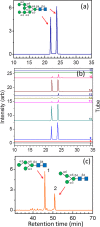Structural identification of N-glycan isomers using logically derived sequence tandem mass spectrometry
- PMID: 36697781
- PMCID: PMC9814355
- DOI: 10.1038/s42004-021-00532-z
Structural identification of N-glycan isomers using logically derived sequence tandem mass spectrometry
Abstract
N-linked glycosylation is one of the most important protein post-translational modifications. Despite the importance of N-glycans, the structural determination of N-glycan isomers remains challenging. Here we develop a mass spectrometry method, logically derived sequence tandem mass spectrometry (LODES/MSn), to determine the structures of N-glycan isomers that cannot be determined using conventional mass spectrometry. In LODES/MSn, the sequences of successive collision-induced dissociation are derived from carbohydrate dissociation mechanisms and apply to N-glycans in an ion trap for structural determination. We validate LODES/MSn using synthesized N-glycans and subsequently applied this method to N-glycans extracted from soybean, ovalbumin, and IgY. Our method does not require permethylation, reduction, and labeling of N-glycans, or the mass spectrum databases of oligosaccharides and N-glycan standards. Moreover, it can be applied to all types of N-glycans (high-mannose, hybrid, and complex), as well as the N-glycans degraded from larger N-glycans by any enzyme or acid hydrolysis.
© 2021. The Author(s).
Conflict of interest statement
C.Y.L., S.-T.T., and C.-K.N. are co-inventors of a United States patent (US 10,796,788 B2) that part of the method described in the patent to determine the carbohydrate structure was used in this work. The remaining authors declare no competing interests.
Figures






Similar articles
-
De novo structural determination of oligosaccharide isomers in glycosphingolipids using logically derived sequence tandem mass spectrometry.Analyst. 2021 Nov 22;146(23):7345-7357. doi: 10.1039/d1an01448j. Analyst. 2021. PMID: 34766961
-
Chromatograms and Mass Spectra of High-Mannose and Paucimannose N-Glycans for Rapid Isomeric Identifications.J Proteome Res. 2024 Mar 1;23(3):939-955. doi: 10.1021/acs.jproteome.3c00640. Epub 2024 Feb 16. J Proteome Res. 2024. PMID: 38364797 Free PMC article.
-
Automatic Full Glycan Structural Determination through Logically Derived Sequence Tandem Mass Spectrometry.Chembiochem. 2019 Sep 16;20(18):2351-2359. doi: 10.1002/cbic.201900228. Epub 2019 Aug 1. Chembiochem. 2019. PMID: 31016827
-
Methods in enzymology: O-glycosylation of proteins.Methods Enzymol. 2005;405:139-71. doi: 10.1016/S0076-6879(05)05007-X. Methods Enzymol. 2005. PMID: 16413314 Review.
-
Collision-induced dissociation tandem mass spectrometry for structural elucidation of glycans.Methods Mol Biol. 2009;534:133-45. doi: 10.1007/978-1-59745-022-5_10. Methods Mol Biol. 2009. PMID: 19277555 Review.
Cited by
-
High-Throughput Multiplexed Infrared Spectroscopy of Ion Mobility-Separated Species Using Hadamard Transform.Anal Chem. 2022 Feb 15;94(6):2912-2917. doi: 10.1021/acs.analchem.1c04843. Epub 2022 Feb 3. Anal Chem. 2022. PMID: 35113536 Free PMC article.
-
The glycosylation in SARS-CoV-2 and its receptor ACE2.Signal Transduct Target Ther. 2021 Nov 15;6(1):396. doi: 10.1038/s41392-021-00809-8. Signal Transduct Target Ther. 2021. PMID: 34782609 Free PMC article. Review.
-
De novo glycan sequencing by electronic excitation dissociation MS2-guided MS3 analysis on an Omnitrap-Orbitrap hybrid instrument.Chem Sci. 2023 Jun 2;14(24):6695-6704. doi: 10.1039/d3sc00870c. eCollection 2023 Jun 21. Chem Sci. 2023. PMID: 37350811 Free PMC article.
-
Recent Advances in Mass Spectrometry-Based Structural Elucidation Techniques.Molecules. 2022 Sep 30;27(19):6466. doi: 10.3390/molecules27196466. Molecules. 2022. PMID: 36235003 Free PMC article. Review.
-
Collision-Induced Dissociation of Fucose and Identification of Anomericity.J Phys Chem A. 2024 May 16;128(19):3812-3820. doi: 10.1021/acs.jpca.4c00640. Epub 2024 May 1. J Phys Chem A. 2024. PMID: 38690855 Free PMC article.
References
Grants and funding
LinkOut - more resources
Full Text Sources
Other Literature Sources

